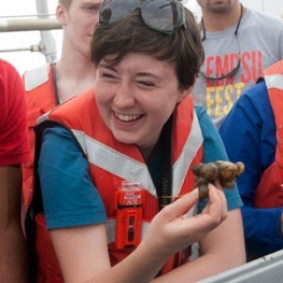Eight students will be presenting the summer work at the Ocean Sciences Meeting in March 2022!
Jenessa Duncombe, Wesleyan University
Class Year:
2013Mentor:
William Boicourt, Ph.D.Project Title:
Wind-induced Lateral Circulation and Mixing in the Chesapeake Bay
Abstract:
The lateral salinity gradient responds to wind and tidal forcing in the Chesapeake Bay with spatial variation in salinity. The layers of isohalines tilt to the western shore during flood tide and slack before ebb tide, while the isohalines flatten during ebb and slack before flood tide, creating a semi-diurnal seesaw motion of the salinity gradient. The degree of the tilt correlates to the sensitivity of the tide to the Coriolis Effect, a phenomenon previously not well understood spatially. Sensitivity to wind forcing occurs on a more drastic scale and results in tilting to the Eastern shore. Up-welling and down-welling zones appear on the shallow shoals during wind events. The shallow shoals also experienced regularly changing salinity from 11-15 PSU within the interval of six hours. Both up-welling and down-welling zones and the seesaw motion of the salinity gradient may indicate lateral mixing.
Location:
Horn Point LaboratoryPresentations:
Duncombe, J*. 2014. Variation in lateral pynocline slope caused by rotationally influenced tides in the Chesapeake Bay . Ocean Sciences Meeting, Honolulu, Hawaii .



